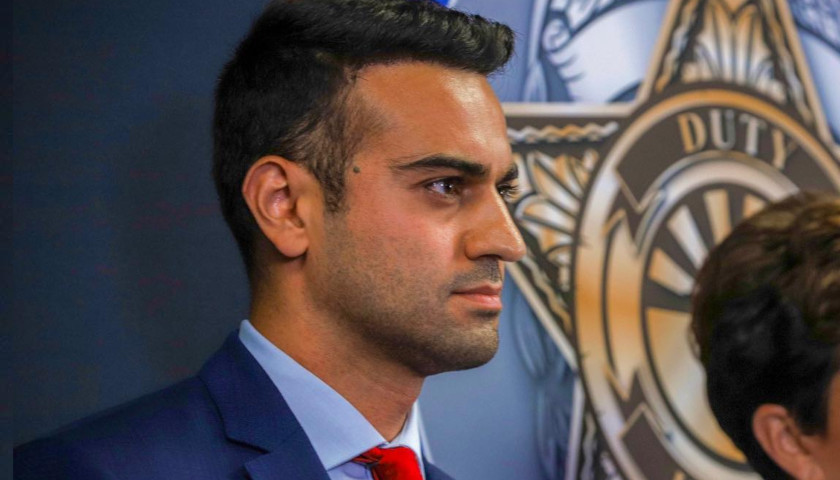Republican Arizona Attorney General candidate Abe Hamadeh is not giving up contesting the election which went to Democrat Kris Mayes by just 280 votes. His first lawsuit challenging the results was dismissed as premature, his second was thrown out by Mohave County Superior Court Judge Lee Jantzen for not showing there were enough problematic votes to change the election, but on Tuesday Hamadeh and the RNC, along with two individuals, filed a motion for a new trial, based on additional evidence of voter disenfranchisement. Hundreds of uncounted ballots were recently found in Pinal County.
Hamadeh said on the Charlie Kirk Show, “We didn’t have these facts. But you know who had these facts? It was Secretary of State @katiehobbs. She had all these facts and she withheld them from the court, she withheld them from me. We weren’t able to present any of this evidence.”
We simply ask that we be given the opportunity to apply the Pinal County process across the board to conduct a physical inspection and hand count of ballots that if the Pinal County issue repeats itself anywhere else in the state could be outcome determinative in this election.
— Abe Hamadeh (@AbrahamHamadeh) January 4, 2023
The 645-page Motion for a New Trial including exhibits cited Rule 59(a)(1) of the Arizona Rules of Procedure, which allows for a new trial if there is “newly discovered material evidence.” The motion cited the 507 new votes found in Pinal County, which shrunk Mayes’ lead from 511 to 280.
The motion argued that “the vote count totals are likely inaccurate, with thousands of Arizonans’ votes not counted, thus casting further doubt about the actual result.” This information was not available at trial, Hamadeh said. “Given this new margin the tiniest errors in counting are enough to change the results, or at least cast them into doubt.”
Hamadeh said Hobbs knew about the missing votes eight days before she told him or the public. “If this is not grounds for a new trial, then nothing is,” he declared in the motion.
The ballots were not counted properly due to poll workers not realizing the voting machines had not read them. Due to this, Hamadeh said “further ballot inspection is necessary to ensure the accuracy of the Attorney General election results.”
The pleading also addressed problems with Maricopa County ballots. “There are still close to 50,000 undervotes in Maricopa County that Contestants asked to examine,” Hamadeh stated, and said he is entitled to examine all the ballots, not just a sample. The motion cited Hunt v. Campbell, where “a meticulous review of the votes cast in the governor’s race was, in fact, outcome determinative.”
The pleading pointed out that Maricopa County Elections Director Scott Jarrett testified that ballots not read by the machines on voting day were not adjudicated, but early ballots that were not read by the machines were adjudicated. This is “disparate treatment” since “Hamadeh lost early ballots by about 15%, [but] he won Election Day voting by 40%.” The motion cited Bush v. Gore, “[T]he State may not . . . by later arbitrary and disparate treatment, value one person’s vote over that of another.”
The motion also pointed out that “Maricopa County finally delivered the list of provisional ballot voters last week pursuant to a public records request made well in advance of trial,” which should be inspected as part of the trial. “Contestants are now in a possession a list of the names of persons who voted provisionally but whose vote was not counted.”
Other than a recount in Santa Cruz County that favored Mayes by one vote, recounts in other Arizona counties favored Hamadeh “that, if the trend continued, could be sufficient to tip the balance of this election.”
Finally, Hamadeh cited new information from Kari Lake’s trial contesting the gubernatorial election results, which “revealed that some ballots in Maricopa County were printed in such a way that their timing marks could not be correctly read, which prevented Maricopa County’s tabulators from properly reading and tabulating a large number of ballots.” It went on, “This means that any votes for Mr. Hamadeh which were erroneously read as undervotes would likely not have been properly recorded, as they eventually were in Pinal County.”
The motion concluded, “Contestants simply ask that we be given the opportunity to apply the Pinal County process across the board to conduct a physical inspection and hand count of ballots that — if the Pinal County issue repeats itself anywhere else in the State — could be outcome determinative in this election.”
Mayes was sworn into office on Monday. A court could still remove her from office and install Hamadeh. In the 1917 Hunt v. Campbell case, after accusations of voter fraud surfaced, the Arizona Supreme Court removed the incumbent Democrat governor 13 months after he’d been sworn into office and replaced him with the Republican challenger. Hamadeh’s motion also cited Reyes v. Cumming, where the court examined early ballots and set aside the results of a contested election 11 months after the previously declared winner had taken office. In close races like Hamadeh’s, the outcome has often flipped.
– – –
Rachel Alexander is a reporter at The Arizona Sun Times and The Star News Network. Follow Rachel on Twitter. Email tips to [email protected].
Photo “Abe Hamadeh” by Abe Hamadeh.





